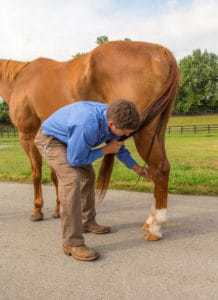
Researchers Compare Joint Injection Options
A comparison of triamcinolone and a triamcinolone/hyaluronic acid combo yielded “unexpected” results, researchers said.


A comparison of triamcinolone and a triamcinolone/hyaluronic acid combo yielded “unexpected” results, researchers said.

If a horse is hind-limb lame, consider issues where the superficial digital flexor tendon (SDFT) attaches to the hock.

By knowing what conditions certain horses are predisposed to, owners and breeders can take preventive steps.

Learn how vets are using an arthroscope that’s 1.3 mm in diameter and 100 mm in length to evaluate stifle problems.

A psyllium/magnesium sulfate combination appears safe and effective for helping horses evacuate sand from their colons.

Researchers are looking for ways to help aging equine athletes through so-called “satellite cells.”

Researchers have identified some important differences between the eyes of horses with and without HERDA.

Here are five ways to help your horse stay healthy and happy through the new year.

Radiographs (X rays) and low-field MRI appear to be useful tools for diagnosing early-stage arthritis.

Corneal dystrophy in Friesians could have a genetic basis, but the condition responds well to appropriate treatment.

While equine surgeons enjoy sharing the mantra “if in doubt, cut it out,” researchers recently reported that when it comes to some OCD lesions, letting nature run its course might be the better option.

Researchers are working to better understand tiludronate’s impact on horses’ joint cartilage.

Find out which foreign animal diseases North American horse owners need to keep an eye on and why.

Just as many human soldiers bravely elect to serve their countries, equids have also been called to duty.

Researchers determined that markers on two chromosomes are associated with the risk of insidious equine recurrent uveitis.

Researchers tested the technique on horses with poor performance and respiratory noise.
Stay on top of the most recent Horse Health news with